Spring Tonics: a
one-day workshop
with Susun Weed at the Wise Woman Center
by Wise Woman Karen Joy
Learn
more about Wise Woman classes with Susun Weed
This one-day workshop was held at the Wise Woman
Center on this gorgeous spring day just this last weekend.
Have any of you ever been to the WWC? It's a treat to see
it in its many seasons. It's loaded with plants, wild and
cultivated, dotting the forested and open land with rocks
jutting up in between (the land used to be used as a stone
quarry, I believe, many years ago). Goats roam free here --
mommas and many kids (papas? I don't know). There are also
2 geese -- Loverboy and Sweetheart. And two cats (that I saw)
-- I think I remember them as mother and son. Of course there
are also many other creatures happily living here.
After parking with assistance and greeting from Susun and
the two apprentices living there at the time (cars' tires
kill the surface microorganisms living in the soil, we learned
this weekend, as well as, of course, any plants. This is a
place that values ALL the life there and doesn't accept its
usual secondary status to vehicles -- so great importance
is placed on driving and parking in designated areas.) . .
. . after parking, we (I believe about 13 women, though men
are welcomed at these) gathered at "the circle",
where infusion awaited us. This day was oatstraw, yum!
 We
spoke in turn with a talking stick, introducing ourselves,
where we reside, and sometimes our reasons for coming and
questions for the day. The talking stick allows us to share
in our moment, uninterrupted, whatever we desire. Susun reminds
us this need not be words, but can be a dance, music, song,
or poem. This day, the first of the season, most of us seemed
a bit shy, sharing "the facts". Two women brought
their babies. One mother brought her mother. Having come long
distances, some of these women stayed the weekend nearby and
got to meet the night before at the moonlodge held every Friday
before Susun's weekend one-day workshops.
We
spoke in turn with a talking stick, introducing ourselves,
where we reside, and sometimes our reasons for coming and
questions for the day. The talking stick allows us to share
in our moment, uninterrupted, whatever we desire. Susun reminds
us this need not be words, but can be a dance, music, song,
or poem. This day, the first of the season, most of us seemed
a bit shy, sharing "the facts". Two women brought
their babies. One mother brought her mother. Having come long
distances, some of these women stayed the weekend nearby and
got to meet the night before at the moonlodge held every Friday
before Susun's weekend one-day workshops.
Susun seems to me to love to share her knowledge. All questions
seem welcome and often come with detailed answers -- I believe
I've heard "there are no stupid questions".
We went out right away for a gentle walk in the woods (there
are something like 45 acres to the Center) stopping often
to visit a plant or tree, learning her beauties. One thing
I remember from taking these classes two years ago is SOO
much learning is offered. Though I think I absorb it all,
I don't always remember it consciously. I could take the same
class every year for ten years (and more) and get new and
deeper understandings of what is presented to me. With that
said, I will share with you some of what I remember.
I remember visiting partridgeberry, or twin flower, getting
close to the ground where she lives and seeing her leaves
and red berries that have been there since last year. I saw
how her berry had two flower ends explaining her second name.
Anyone who has learned from Susun knows how she abounds with
stories. This is probably one of the best ways I have encountered
for remembering what I have learned, though sometimes they
are just pure enjoyment. I heard of a girl who, after seeing
all these red berries in a partridge belly, concluded these
partidges "laid" them there all over the forest
floor. Makes sense to me!
Wintergreen, we were told, who also lies close to the ground
and has similar looking red berries (at first glance anyway),
tastes dramatically different. Its berries taste like wintergreen,
while mitchella repens (partridge berry) has extremely tasteless
berries.
Though the specifics I can't remember, my largest impression
of this plant is it is a wonderful ally for women! I also
remember reading this in an article on Susun's website about
fertility.
Please don't take my lack of detailed knowledge as an indication
of what's offered at the class. Some women chose to take notes
and could probably recite many "facts" about this
plant alone. I chose to learn differently. I listen and watch
and feel and don't put much priority on memorization except
when there is something specific I really want to know NOW.
 I
prefer a feeling in my body that allows me to spot this plant
when walking the woods and feel it as a woman's friend, rather
than words without feeling. I know in time, as my learning
works into deeper layers, this knowledge will come along with
the feeling. So when a time comes that I am looking for a
"woman's friend" I will research more of the details,
and they will be familiar because I know that all I heard
in this class and others lives in me. Can anyone else relate
to the type of learning I am talking about?
I
prefer a feeling in my body that allows me to spot this plant
when walking the woods and feel it as a woman's friend, rather
than words without feeling. I know in time, as my learning
works into deeper layers, this knowledge will come along with
the feeling. So when a time comes that I am looking for a
"woman's friend" I will research more of the details,
and they will be familiar because I know that all I heard
in this class and others lives in me. Can anyone else relate
to the type of learning I am talking about?
Okay, so back to our walk. We visited eastern hemlock (thuja?)
and white pine, both predominant in our area. We tasted them.
We experienced them as we chewed, encouraged by Susun to notice
the sensations in our mouth. The hemlock, I noticed, made
my mouth get wetter. It encourages mucus production, she shared,
and mucous is good! Yes, it protects us, cushions us, it lines
our sensitive skin. We want it. Perhaps, then, I thought,
the mucous that accompanies a cold, isn't the "evil cold"
itself, but our protection kicking in. And, perhaps, why steaming
our face over a pot of hemlock needle brew, clears the stuck
mucous isn't because it is "drying" (as my experience
chewing it proved), but because it encourages the production
of mucous, allowing it all to move!
As we moved from plant to tree to plant we heard of properties
in plants and the best mediums to extract them in. All of
this, of course, can be read in articles written by Susun
and her books, and though this is wonderful knowledge, it
cannot, for me, compare to the memory sensation that goes
with the moment of hearing it from her.
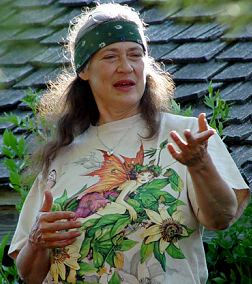 For
example, I have read more than once before about extracting
the oils in a plant with oil (olive oil). So though this is
not new to hear, now I can know this with the taste of the
oil from the hemlock needles I am chewing in my mouth, the
sight of this tree's branches in front of me, the women I
have just met all around me, and all the sights, sounds, and
smells, that go along with a beautiful spring day in the woods.
For
example, I have read more than once before about extracting
the oils in a plant with oil (olive oil). So though this is
not new to hear, now I can know this with the taste of the
oil from the hemlock needles I am chewing in my mouth, the
sight of this tree's branches in front of me, the women I
have just met all around me, and all the sights, sounds, and
smells, that go along with a beautiful spring day in the woods.
We were told how white pine carries five needles in a bunch,
less common in a pine than three. Looking at the base of these
needles we see white, hence its name, and I hear Susun say
while counting on her 5 fingers W-H-I-T-E, five needles in
a bundle!
We look down the hill and around the corner from this pine
and and see big (for this time of year) green plants along
the hillside. We curiously surround them, these leaves reminiscent
in shape, color and size of lily bulbs I have been seeing
lately emerge from the ground. What family does this remind
you of? we are asked. Liliaceae, someone knows. What plants
are in this family? we are also asked. People say what, if
any, they know. Among the many pretty flowers common to spring,
some mention onions, garlic, etc. We are encouraged by Susun
to smell and taste a leaf that offers itself to us. Yum, onion!
They are ramps.
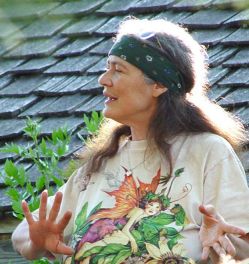 Before
we head back for lunch (yes, we're not even half done with
class!) we visit two more plants growing near each other at
the bottom of the hill near wet land. They are wild chives
and trout lily. We sit among them, taste them, and listen
to Susun share much knowledge about them.
Before
we head back for lunch (yes, we're not even half done with
class!) we visit two more plants growing near each other at
the bottom of the hill near wet land. They are wild chives
and trout lily. We sit among them, taste them, and listen
to Susun share much knowledge about them.
We walk back to the deck we will be eating lunch on. Susun
goes inside to heat the nettle soup she explains was prepared
the night before so the nettles could infuse in the water
overnight. The two apprentices took two groups of women who
wanted to help collect wild greens to add to the salad. They
were the tender tips of madder (gallium - related to the sweet
woodruff that is often made into "may wine") and
garlic mustard leaves pinched off where they meet the stem.
Garlic mustard has a bit of bite like mustard, and a taste
of garlic.
The bell was rung, we sang a song and we ate a feast of salad
with wild greens and nettle soup. Water and infusion was provided
to drink. So were condiments -- olive oil, salt, tamari, miso,
gomasio, and a sampling of vinegars. Other than umeboshi vinegar
the others were herbal ones made from plants we were introduced
to this day. And I certainly can't forget the bread from freshly
ground organic grains baked by one of the apprentices (I am
so sorry I am not remembering their names right now).
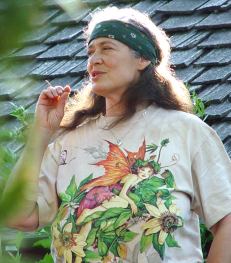 Organic
butter was provided as was delicious!!!! cheeses made there
from the goats' milk -- three kinds, garlic, aged and wild
chives. I have to say such a simple sounding meal is heavenly
(more accurately, earthly) and left me bored that night with
my more complicated or empty feeling comfort foods like pasta.
In fact I went home that night and drank the nettle infusion
I (thankfully) prepared that morning before class.
Organic
butter was provided as was delicious!!!! cheeses made there
from the goats' milk -- three kinds, garlic, aged and wild
chives. I have to say such a simple sounding meal is heavenly
(more accurately, earthly) and left me bored that night with
my more complicated or empty feeling comfort foods like pasta.
In fact I went home that night and drank the nettle infusion
I (thankfully) prepared that morning before class.
After lunch we stayed nearer to the house and the gardens
there fenced off from munching goats and such. There was sweet
birch (which actually I think we visited before lunch). The
description for this class mentions we will "bite buds"
which indeed we did -- sweet birch buds, yum! Wild root beer
or sarsaparilla? We learned how her sap is flowing now and
won't stop if tapped. We watched the drip drip of her yummy
water from the thin branches where her buds were taken.
We learned how to collect these thin branches (with scissors
please for a clean cut), the length of a quart canning jar
and a bundle that would fit in the circle made by connecting
my thumb and longest finger. We could the put them in the
jar and pour boiling water over them, cover and let infuse
overnight. We could drink the mild brew in the morning, we
could then pour more boiling water over the same branches
and drink that night. The taste would be a little stronger!
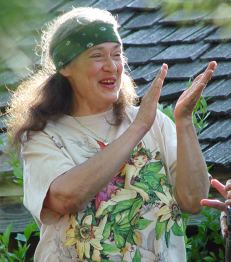 We
could repeat this process with the same branches day after
day, with the taste getting stronger each time. At some point
around the fourth day I think is when I would stop drinking
and start cleaning with the water! Susun says it is a wonderful
degreaser. I think I remember her saying this could go on
for about a month. How's that for a spring tonic?!
We
could repeat this process with the same branches day after
day, with the taste getting stronger each time. At some point
around the fourth day I think is when I would stop drinking
and start cleaning with the water! Susun says it is a wonderful
degreaser. I think I remember her saying this could go on
for about a month. How's that for a spring tonic?!
A wonderful taste of a tree's spring sap in my water, then
something to help my spring fever desire to clean out winter!
My understanding from Susun was this is a wonderful spring
tonic, though not something to use as one of our regular nourishing
infusions. In fact, if we wanted we could dump the first few
days of brew to get to the cleaning water. I personally savor
my spring cups of sweet birch water.
We visited more plants and at this point I am confused which
were on this day and which on the next. And since this is
long enough I will continue in my next post about the Sunday
class "herbal medicine chest" which will probably
come tomorrow!
Thanks for listening! I hope you enjoyed my memory of this
"spring tonics" class.
karen joy
info@ashtreepublishing.com
Learn
more about Wise Woman classes with Susun Weed
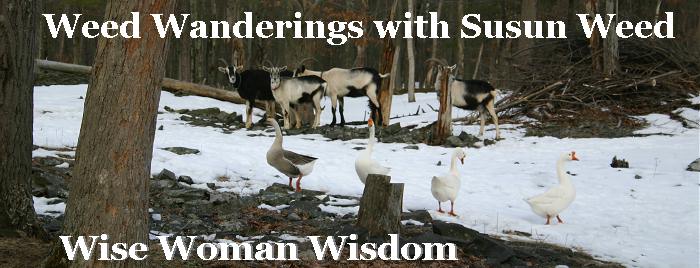


 For
example, I have read more than once before about extracting
the oils in a plant with oil (olive oil). So though this is
not new to hear, now I can know this with the taste of the
oil from the hemlock needles I am chewing in my mouth, the
sight of this tree's branches in front of me, the women I
have just met all around me, and all the sights, sounds, and
smells, that go along with a beautiful spring day in the woods.
For
example, I have read more than once before about extracting
the oils in a plant with oil (olive oil). So though this is
not new to hear, now I can know this with the taste of the
oil from the hemlock needles I am chewing in my mouth, the
sight of this tree's branches in front of me, the women I
have just met all around me, and all the sights, sounds, and
smells, that go along with a beautiful spring day in the woods. Before
we head back for lunch (yes, we're not even half done with
class!) we visit two more plants growing near each other at
the bottom of the hill near wet land. They are wild chives
and trout lily. We sit among them, taste them, and listen
to Susun share much knowledge about them.
Before
we head back for lunch (yes, we're not even half done with
class!) we visit two more plants growing near each other at
the bottom of the hill near wet land. They are wild chives
and trout lily. We sit among them, taste them, and listen
to Susun share much knowledge about them.

